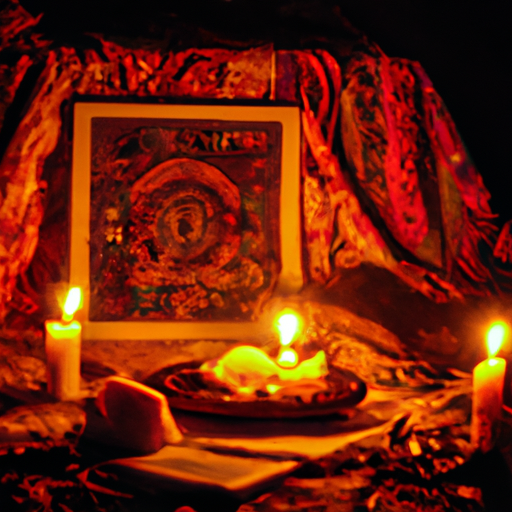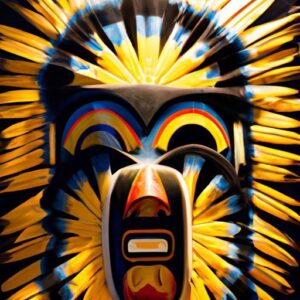– **The Role of Dreams in Healing Practices**
Introduction
Dreams have long been a subject of fascination and mystery, with many cultures attributing significant importance to them. Among these, the Apache people hold a profound belief in the healing power of dreams. According to Apache wisdom, dreams serve as a bridge between the physical and spiritual worlds, offering insights and guidance for personal growth and well-being.
In Apache tradition, dreams are not merely random images but are seen as messages from the spirit world. These messages can provide solutions to problems, warn of impending dangers, or reveal hidden truths about oneself. Consequently, dreams are often consulted in times of illness or emotional distress, playing a crucial role in the healing practices of the Apache people.
The use of dreams as a form of healing extends beyond the individual to the community. Dream interpretations are shared with elders or shamans, who use their wisdom to guide the dreamer towards a path of healing. This communal approach underscores the idea that healing is not just a personal journey but a collective responsibility, woven into the fabric of Apache society.
Understanding the role of dreams in Apache healing practices offers valuable insights into a holistic approach to health. By acknowledging the spiritual dimensions of well-being, it encourages a more comprehensive view of healing that integrates mind, body, and spirit. This perspective can inspire modern health practices to incorporate elements of spiritual healing and communal support, enriching the overall approach to wellness.
History
For centuries, the Apache people have viewed dreams as powerful tools for healing. In Apache culture, dreams are considered a bridge between the physical world and the spiritual realm, providing insights and guidance. Tribal elders often interpret dreams, believing they reveal important messages from ancestors and spirits.
Ancient Apache healing practices incorporate dreaming as a core component. Dreamers are thought to connect with spiritual beings who offer healing knowledge and techniques. These insights are then used to treat illnesses, both physical and emotional, within the community.
The practice of using dreams for healing is not limited to shamans or medicine men; it is a communal endeavor. Individuals of all ages are encouraged to share their dreams, fostering a collective understanding and approach to well-being. This tradition underscores the Apache belief in interconnectedness and the importance of communal harmony.
“The Great Spirit often speaks to us through dreams, guiding us towards healing and balance,” an Apache elder once said.
An Apache story
The Apache people have long held a deep reverence for dreams, viewing them as conduits of wisdom and guidance from spiritual realms. In their tradition, dreams are not dismissed as mere imaginings but are considered vital messages to be interpreted and heeded. They believe that through dreams, ancestors and spiritual guides offer insights that can lead to profound healing.
Among the Apache, there are stories of medicine men and women who received their healing powers through dreams. One such story tells of a young warrior who was gravely injured in battle and fell into a deep sleep. During his rest, he dreamt of an elder who instructed him on the use of specific herbs and roots that would restore his health. Upon awakening, he followed the guidance from his dream and fully recovered, eventually becoming a revered healer in his community.
These healers often keep dream journals and place great importance on recording their dreams to decipher their meanings accurately. They might consult with other elders or shamans to interpret the symbology contained in their dreams. This practice underscores the belief that dreams are sacred tools that can unveil the nature of a person’s ailment and the steps needed for restoration.
The Apache story of the young warrior illustrates the community’s holistic approach to wellness, integrating body, mind, and spirit. Dreams serve as a bridge between the physical world and the spiritual domain, providing essential insights that support their healing practices. This ancient wisdom continues to be revered and practiced, highlighting the enduring power of dreams in the Apache healing tradition.
Sitting by the fire, Grandmother Nalin began her tale. Her voice flowed like the wind through the endless desert plains, carrying ancient wisdom. “Listen, my children,” she said, “for tonight I will tell you the story of Taza and the Dream Spirit.”
Taza, a young warrior from our tribe, had fallen ill. His body was strong but his spirit was weary. No remedy could cure his affliction. His mother, Kimana, desperate for her son’s recovery, sought help from the tribe’s shaman, Amadahy. The shaman, a wise man with eyes like the night sky, advised, ‘The Dream Spirit must guide him.’
For seven nights, Taza remained in the sacred teepee, surrounded by healing herbs and the scents of sage and cedar. Each night, Amadahy chanted ancient songs, his voice melding with the crackling of the fire. On the seventh night, Taza fell into a deep slumber.
In his dreams, he found himself in a vast canyon, its walls adorned with the stories of his ancestors. Suddenly, a majestic eagle appeared. The bird’s feathers gleamed in the moonlight, and its eyes pierced through Taza’s soul. The eagle spoke, ‘Taza, you must journey through the Canyon of Shadows to find the Healing Stone.’
Taza embarked on this dream journey, facing daunting challenges. He crossed rivers of fire and scaled mountains of ice. Each challenge tested his bravery and resolve. Finally, he found the Healing Stone, glowing with a serene, blue light. When he touched it, a warm wave of energy flowed through him.
He awoke in the teepee as the first light of dawn touched the horizon. His mother and Amadahy waited. The weary lines on Taza’s face had smoothed, his eyes sparkled with renewed vitality. ‘The Dream Spirit showed me the way,’ he whispered.
Grandmother Nalin smiled at the children, her eyes reflecting the flickering firelight. “Remember, my children,” she concluded
Implementing it in your life
To incorporate the healing wisdom found in Apache traditions regarding dreams, start by setting aside time each morning to reflect on your dreams. Keep a dream journal by your bedside to quickly jot down any details you remember. This practice not only helps in retaining dream content but also aids in identifying patterns or recurring themes that may need your attention.
Engage with your dreams actively by meditating on them or discussing them with a trusted friend or family member. This bridges the conscious and subconscious mind, allowing for deeper self-awareness and facilitating the healing process. Recognize that dreams can offer guidance and solutions that are not immediately apparent in your waking life.
- Maintain a consistent sleep schedule to facilitate regular dream activity.
- Practice relaxation techniques before bed, such as breathing exercises or gentle yoga.
- Set an intention before sleep to remember and understand your dreams.
- Record your dreams immediately upon waking, noting all details and emotions felt.
- Review your dream journal periodically to identify patterns or recurring themes.
- Seek insights from your dreams by meditating or reflecting on their symbols and messages.
- Share significant dreams with friends or a support group to gain different perspectives.
By following these steps, you begin to see dreams not merely as random occurrences but as tools for growth and healing. Each dream becomes a potential source of insight, helping you understand deeper aspects of yourself and your life journey.
This dedication to dream work can lead to increased self-awareness and emotional resilience. As you integrate the messages from your dreams, you become more attuned to your inner wisdom and navigate life with a clearer, more balanced mindset.
Conclusion
In conclusion, the role of dreams in healing practices, as inspired by Apache wisdom, emphasizes the profound connection between our inner selves and the spiritual realm. Dreams are seen as a vital channel through which we can receive guidance, heal emotional wounds, and foster a deeper understanding of our life’s journey. This ancient wisdom teaches us the value of paying attention to our dreams and integrating their messages into our daily lives.
The Apache people believe that dreams can serve as a bridge to the spiritual world, offering insights that can lead to healing and personal growth. By embracing this perspective, we can cultivate a deeper appreciation for the symbolic language of dreams and their potential to transform our understanding of health and wellness. Incorporating dream interpretation into contemporary healing practices can provide a holistic approach to mental and emotional well-being.
“He who dreams must listen, and in listening, he will heal.”
As we continue to explore the intersection of dreams and healing, let us be inspired by Apache wisdom to honor the messages from our dreams. Consider keeping a dream journal, sharing your dreams with a trusted friend or healer, and reflecting on how these nocturnal visions can guide your personal healing journey. Embracing the power of dreams not only connects us to ancient traditions but also opens up new avenues for self-discovery and holistic health.
The image and article have been augmented with AI.
Further Study:
- What is the importance of dreams in Apache spiritual beliefs?
- How do Apache people view the concept of healing in their spiritual practices?
- How do Apache people view the concept of spiritual healing?
- What is the role of the spirit world in Apache spiritual beliefs?
- What is the significance of the bow and arrow in Apache spiritual symbolism?
- How do Apache people incorporate spiritual practices into their approach to art and creativity?
- How do Apache people incorporate spiritual practices into their approach to sports and physical activities?
Thank you for reading!







